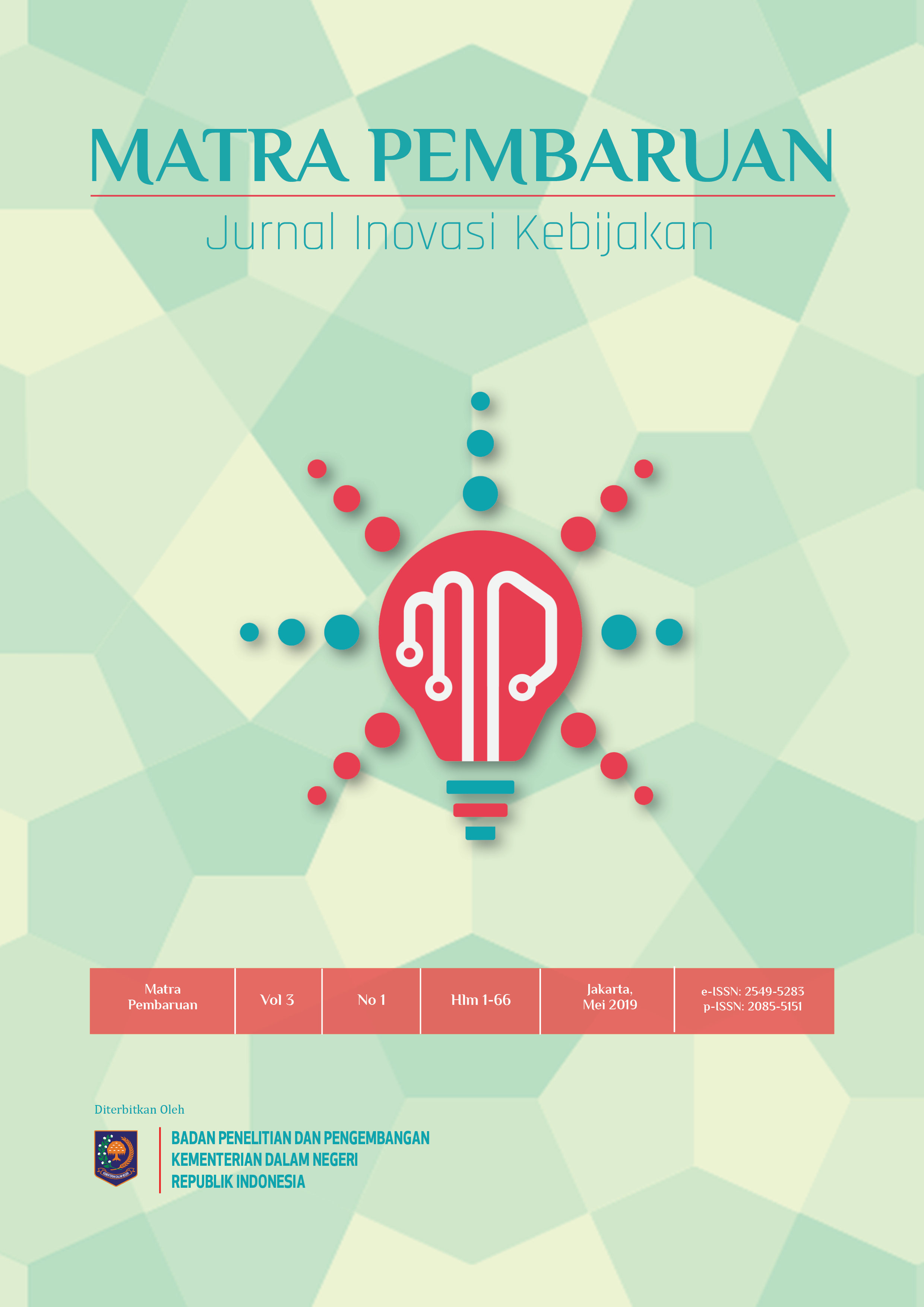Kesesuaian Kegiatan Dana Alokasi Khusus (DAK) Pariwisata dan Permasalahan Pariwisata di Indonesia
DOI:
https://doi.org/10.21787/mp.3.1.2019.25-36Keywords:
Tourism, Specific allocation grant, Environment resilienceAbstract
Today's, tourism industry has developed into an important industry and has a significant impact on national development efforts through state revenuesas well as in the regions. Indonesia itself, has long been known as one of the world tourism destination. Various forms and types of tourism exist and grow in Indonesia. Therefore, since 2008, the government continues to develop the tourism sector as one of the priority sectors in national development, including the development program of 10 New Tourism Destinations beside Bali in 2015. Government commitment is also realized in the aspect of funding, through the allocation of APBN especially Transfer to Region in the DAK Physical on Tourism sector. To be beneficial, the allocation is certainly expected to be right on target. For this reason, an analysis of the conformity between the allocation of DAK Physical on Tourism Sector and the real problems in the national tourism sector is needed. This study then tried to answer these needs by using the menu evaluation analysis method and the DAK Physicalon Tourism allocation activities. From the results of the analysis since 2016, in general it can be said that the allocation of Physical DAK in Tourism has been aligned with the real problems in the national tourism sector, especially related to indicators of security and safety, health and hygiene, ICT readiness and tourism infrastructure services. The Physical DAK Allocation of Tourism from 2016-2018 still has not touched the indicator of the problem of environmental resilience which should be considered in the future.
References
A., R. (2013). Desentralisasi Fiskal dan Pertumbuhan Ekonomi Serta Kaitannya Dengan Otonomi Daerah. Jurnal Borneo Administrator, 9(3). https://doi.org/10.24258/jba.v9i3.124
Ati, N. P. D. R., Bagia, I. W., & Suwendra, I. W. (2014). Analisis Penurunan Pendapatan Sektor Pariwisata Sebuah Kajian Dari Perspektif Manajemen Keuangan. Jurnal Jurusan Manajemen, 2(1), 23–43. Retrieved from https://ejournal.undiksha.ac.id/index.php/JJM/article/view/2089
Dwyer, L., & Kim, C. (2003). Destination Competitiveness: Determinants and Indicators. Current Issues in
Tourism, 6(5), 369–414. https://doi.org/10.1080/13683500308667962
Evita, R., Sirtha, I. N., & Sunarta, I. N. (2012). Dampak Perkembangan Pembangunan Sarana Akomodasi Wisata Terhadap Pariwisata Berkelanjutan di Bali. Jurnal Ilmiah Pariwisata, 2(1), 109–222. Retrieved from https://ojs.unud.ac.id/index.php/jip/article/view/3684
Handra, H., & Paddu, H. (2012). Evaluasi Kinerja Pelaksanaan DAU dan DAK. Jakarta.
kontan.co.id. (2014). WTTC: Pariwisata Indonesia tumbuh paling tinggi. Retrieved May 6, 2019, from https://industri.kontan.co.id/news/wttc-pariwisata-indonesia-tumbuh-paling-tinggi
Leedy, P. D., & Ormrod, J. E. (2005). Practical Research: Planning and Design. New Jersey: Prentice Hall. Retrieved from https://books.google.co.id/books/about/Practical_Research.html?id=MipiQgAACAAJ&redir_esc=y
McIntosh, R. W., & Goeldner, C. R. (1986). Tourism : Principles, Practices, Philosophies (Third Edition). Northwestern: Wiley. Retrieved from https://books.google.co.id/books/about/Tourism.html?id=gVoXAQAAMAAJ&redir_esc=y
MihaliÄ, T. (2000). Environmental management of a tourist destination. Tourism Management, 21(1), 65–78. https://doi.org/10.1016/S0261-5177(99)00096-5
Nudin, J. (2018). Strategi Pemasaran Pariwisata Indonesia Sebagai Antisipasi Dari Perubahan Ekonomi Global. Jurnal Mandiri, 1(2), 311–328. https://doi.org/10.33753/mandiri.v1i2.24
Pratama, M., & Muktiali, M. (2016). Kajian Penurunan Pariwisata di Dataran Tinggi Kerinci Provinsi Jambi. Teknik PWK (Perencanaan Wilayah Kota), 5(1), 29–40. Retrieved from https://ejournal3.undip.ac.id/index.php/pwk/article/view/10622
Prideaux, B. (2000). The Role of The Transport System in Destination Development. Tourism Management, 21(1), 53–63. https://doi.org/10.1016/S0261-5177(99)00079-5
Raharjana, D. T. (2012). Membangun Pariwisata Bersama Rakyat: Kajian Partisipasi Lokal Dalam Membangun Desa Wisata di Dieng Plateau. Jurnal Kawistara, 2(3), 225–328. https://doi.org/10.22146/KAWISTARA.3935
Rani, D. P. M. (2018). Pengembangan Kesejahteraan Masyarakat melalui Sektor Pariwisata pada Pantai Lombang, Kabupaten Sumenep, Madura, Jawa Timur. Jurnal Politik Muda, 3(3), 412–421. Retrieved from http://journal.unair.ac.id/JPM@pengembangan-potensi-pariwisata-kabupaten-sumenep,-madura,-jawa-timur-(studi-kasus-article-8100-media-80-category-8.html
Rinaldi, U. (2013). Kemandirian Keuangan dalam Pelaksanaan Otonomi Daerah. Jurnal EKSOS, 8(22), 105–113. Retrieved from https://core.ac.uk/download/pdf/11718149.pdf
Rutherford, D. (2006). Approaches to Tourism Planning. Pretoria: University of Pretoria.
Setyowati, N. W., & Octavia, S. (2016). Pengembangan Kesejahteraan Masyarakat melalui Sektor Pariwisata pada
Kawasan Wisata Danau Napabele Provinsi Sulawesi Tenggara. Jurnal Administrasi Kantor, 4(2), 374–392. Retrieved from https://www.neliti.com/id/publications/234522/pengembangan-kesejahteraan-masyarakat-melalui-sektor-pariwisata-pada-kawasan-wis
sindonews.com. (2019). Menggarap Serius Wisata Selain Bali. Retrieved May 6, 2019, from https://ekbis.sindonews.com/read/1368636/34/menggarap-serius-wisata-selain-bali-1546908970
Soebagyo. (2012). Strategi Pengembangan Pariwisata di Indonesia. Jurnal Liquidity, 1(2), 153–158. Retrieved from https://www.academia.edu/7701501/STRATEGI_PENGEMBANGAN_PARIWISATA_DI_INDONESIA
Suharso. (2009). Perencanaan Objek Wisata dan Kawasan Pariwisata. Malang: PPSUB.
Trisnawati, R., Wiyadi, W., & Priyono, E. (2008). Analisis Daya Saing Industri Pariwisata Untuk Meningkatkan Ekonomi Daerah: (Kajian Perbandingan Daya Saing Pariwisata Antara Surakarta Dengan Yogyakarta). Economic Journal of Emerging Markets, 13(2), 61–70. Retrieved from https://journal.uii.ac.id/JEP/article/view/224
Utami, A. R. (2016). Kompetensi Khas di Sektor Pariwisata. ESENSI, 6(1), 75–88. https://doi.org/10.15408/ess.v6i1.3122
Warpani, S. P. (2007). Pariwisata dalam Tata Ruang Wilayah. Bandung: Penerbit ITB.
Downloads
Published
How to Cite
Issue
Section
License
Copyright (c) 2019 Author(s)

This work is licensed under a Creative Commons Attribution-NonCommercial-ShareAlike 4.0 International License.
The Creative Commons-Attribution-Noncommercial-Share Alike License 4.0 International applies to all works published by Matra Pembaruan: Jurnal Inovasi Kebijakan. Authors will retain copyright of the work.

















